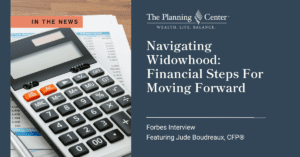For years, we’ve been talking to clients as an industry about the need to save. Put money into your 401k, contribute to your IRAs, and one day you’ll be ready to retire and that savings will become income for you.
So when you get to retirement, how does that actually happen?
We’ve been talking clients through a structure that we like and that seems to work well, and here’s a general overview.
1 – Determine how much you need to spend to live a life you enjoy. This is always our first question. It requires breaking down some details, but ultimately it drives the rest of the decisions that need to be made. How much money do you need each month to cover your essential expenses, and to also cover the fun things that you’d like to do in retirement? Tracking this spending for the first few years of retirement is critical, since expenses can run higher than expected. You’ll want to be aware of these fluctuations and make adjustments accordingly.
2 – Make the Most of your Income (Pensions, Social Security, Real Estate, etc.) – There’s a tremendous amount of benefit that some smart planning can do for you, particularly regarding Social Security income. If you’re married and are within a few years of each other in age you can make the most of strategies like claiming spousal benefits prior to turning on your individual income stream, that can boost retirement income substantially. Choices like taking Social Security at 62, 66, or 70 can cut your retirement income by 25% or boost it by an additional 32%, so run through the numbers in your personal situation and make the decision that’s right for you. If your income comes in the form of rental properties, then do you need to factor in expenses for maintenance, and possibly hiring a property management company so you’re not taking those phone calls while you’re on vacation? All income sources come with tradeoffs, and an exploration of those pluses and minuses is important when making a big transition.
3 – How much risk are you comfortable with taking in retirement? Clients often express a concern about markets and fluctuation in retirement, yet the reality is that we’re probably planning for a 30-40 year retirement with inflating expenses every year. It’s likely that some allocation to growth assets is helpful if not necessary to meet retirement goals, but every situation is different.
4 – How much income do you need your savings to generate every year? The answer to this question and to the risk question above can help you determine how your portfolio can be allocated to meet your goals. Once you know how much you need each year, you can then begin to formulate a distribution strategy, which we will cover in more detail in an upcoming post.
5 – How important is it to leave behind assets to heirs? For some clients this is a top priority, for others they want to spend as much as possible while they can. Like most planning questions there are no right or wrong answers, just the answer that fits your situation. If you plan to leave behind a substantial inheritance, just be aware that it might place limitations on the amount of income your portfolio can generate.
Five simple steps but each with big impacts on your ability to live the life you want to live in retirement.





